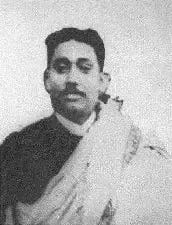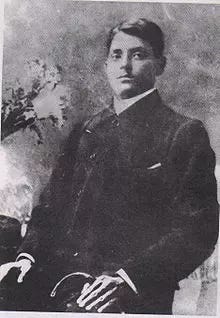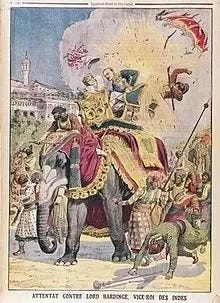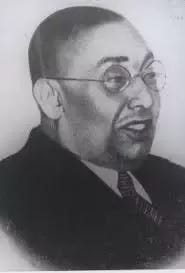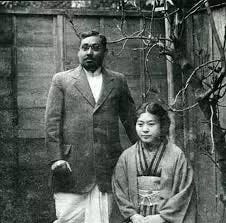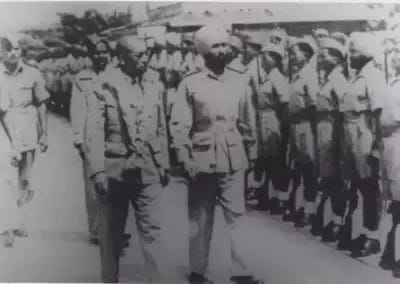"The story of Mr. Rash Behari Bose forms a vital part of India's struggle for independence, and the victory which was finally achieved was in no small measure due to his organizational skill and wonderful spirit of sacrifice. If Netaji came out in the fight as Garibaldi of the movement, Rash Behari's part in the drama was more than that of a Mazzini”- Thakin Nu, ex-Prime Minister of Myanmar.
There is a whole lot to Rash Behari Bose, one of the masterminds behind the plan to assassinate Lord Hardinge, the Viceroy, a key mover in the Ghadr conspiracy, meant to weaken the British army from inside, a master of disguise, camouflage and the founder of the Indian National Army. In many ways Rash Behari was the opposite of his more famed namesake, Subash Chandra Bose. Netaji was a brilliant orator, one who could motivate people to shed blood for the cause of freedom, the charismatic leader, who could sway the masses like none another. Rash Behari on the other hand was more subdued, with a somber voice, in a sense he was the quite brains behind the scene, strategizing and building up the movement. And while Rash Behari had his own escapades from the British, remember he changed his residence 17 times in Japan just to avoid detection, nothing like Bose journey in a German U Boat, half away around the world to Japan, or his trek across Central Asia. And yet in a way both men had the same burning desire for freedom, both nationalists, who believed that only an armed revolution could liberate India.
The man, who would receive the Order of the Rising Sun and lay the foundation for the Indian Army, was born in Subaldaha village of Burdwan district in 1886 to Binod Behari Bose, a small clerk. With his mother passing away when he was just a baby, he was bought up by his maternal aunt Vama Sundari. He did his education from the Dupleix College, Chandernagore, which then was under control of the French. From an early age, Rash Behari was influenced by both French and British political thought and the French revolution particularly motivated him. His teacher Charu Chand also ignited the revolutionary in him. Bankim Chandra Chatterjee’s Ananda Math, was one of the books that shaped his ideological thought, the other one was Nabin Sen’s Plasir Yuddha, a collection of patriotic poems. The speeches of Surendranath Banerjee, Swami Vivekananda deeply influenced him. For some time Rash Behari Bose went through a series of jobs, at Fort William, later the Govt. Press in Shimla and the Pasteur Institute in Kasauli. He finally settled at the Forest Research Institute in Dehradun, where he worked as a head clerk.
Bagha Jatin
It was at Dehradun, that Rash Behari Bose soon got involved in the revolutionary activities, maintaining close contacts with the revolutionary leaders in Bengal and Punjab. He took advantage of the cover his job provided, to execute his plans for manufacturing bombs, as also coordinating with the other revolutionaries. In a way Rash Behari emerged as the link between the revolutionaries in Bengal with those in UP and Punjab. Amarendra Chatterjee who was in charge of the Jugantar’s revolutionary activities in UP, Bihar and Odisha, got Rash Behari in contact with Jatin Mukherjee aka Bagha Jatin, its main leader. The meeting with Bagha Jatin whom Bose described as a “real leader of men” was what gave the impetus to his revolutionary zeal. He planned for an 1857 sort of uprising, interacting with native Indian officers at Fort Williams. He also came in touch with Jatindranath Banerjee aka Niralamba Swami one of Aurobindo’s closest associates, with whom he met many members of the Arya Samaj.
In 1911, the British Government decided to change the capital from Kolkata to Delhi, a decision that was politically motivated in a way against the rising tide of nationalism in Bengal. The revolutionaries decided to strike by assassinating the then Viceroy Lord Charles Hardinge, and hatched the plan in 1912. Rash Behari was the mastermind behind this plan, and on Dec 23, 1912, a bomb was hurled at Hardinge, at a procession in Chandni Chowk, where he was travelling on an elephant. While the mahout was killed in the attack, the bomb narrowly missed its target, though Hardinge was badly injured. Basant Kumar Biswas who threw the bomb was captured, convicted and executed, after a huge manhunt and crackdown on the revolutionaries. Veer Savarkar described the incident thus
On the breast of our Motherland, a carpet of national humiliation was spread out and dancers moved on it. For the nation, it was a funeral procession. Naturally when others in Chandni Chowk showered flowers and coconuts, the representatives of those who had felt the insult, hurled a bomb which routed the elephant, killed one of the A.D.C'.s and gave a blood-bath to the Viceroy. For five minutes everybody believed that Hardinge was dead. Verily the triumphant procession was turned into a funeral.
Rash Behari however managed to evade the British intelligence, went back to Dehradun, attended to his job like before, without any suspicion. He took with him a truckload of bombs and even offered to assist the British in their investigation. However knowing that he would be discovered sooner or later, he went underground. Soon the British were aware that he was the chief conspirator and he had a prize of 75,000 on his head, with his pictures in all public places. However the efforts were in vain, with Rash Behari managing to give cops the slip always.
Rash Behari‘s activities continued unabated, and the Ghadar revolution breaking out provided him the next opportunity. With the outbreak of World War I in 1914, the Ghadar party began to plan an armed uprising against the British, with Indian emigrants in US, Canada and the Far East. While these revolutionaries had the arms and money, they lacked the leadership, and Rash Behari Bose filled that gap. It was Vishnu Ganesh Pingle, a US returned Ghadarite who convinced Rash Behari to lead the movement in India. Rash Behari had both the brains as well as the physical strength to pull off this uprising, and Feb 21, 1915, was when it was planned. As per plan Indian soldiers and officers in the British army, would revolt, capture British officers and take over. However thanks to a traitor called Kirpal Singh, the plans were leaked out, and the revolt was put down. Many of the conspirators were captured, and Vishnu Pingle, Bhai Kartar Singh were among those captured and executed.
With the massive crackdown, Rash Behari’s friends and associates felt he should leave the country and lead the revolutionary movement from abroad. One of his friends J.M.Chatterjee a barrister, raised the funds for his travel to Japan, and using the alias of Raja P.N.T.Tagore, a distant relative of Rabindranath Tagore, he left for Japan in May 1915. In his own words
I presented to the Commissioner of Police, Calcutta, as one of Gurudev Tagore's Secretaries, proceeding to Japan to make arrangements for his visit to Tokyo. And I came out on a British passport.
En route Bose spent some time in Shanghai, and on June 1915 he landed in Japan. However by now he had become a wanted man and the British were pressurizing the Japanese authorities to extradite him. He would spend his next 30 years in Japan, integrating with the society there, marrying a Japanese woman and where he pursued his dream of a Pan Asian alliance against British imperialism. Mitsuru Toyama one of the influential rightist leaders in Japan, was the one who first offered him refuge. Though Japan at that time was an ally of Britain during WWI, Toyama was against it, as he felt the British were the ones making money out of Japan’s ports. Though the Japanese authorities were pressurized to extradite Bose, none of the police dared to enter Toyama’s residence. Bose managed to evade, the police, but lived like a fugitive in Japan for a long time, changing residence 17 times no less. It was during his stay in Japan, that he also met Heramblal Gupta and Bhagwan Singh of the Ghadr Party and in November 1915, he organized a meeting at Sayoken Hotel in Tokyo, which was also attended by Lala Lajpat Rai.
During his stay in Tokyo, Bose lived with the Soma family who owned the Nakamura-ya bakery there in the business district of Shinjuku. The narrow alleyways and bustling streets of Shinjuku gave him the perfect place to evade capture. Aizo Soma, the patriarch believed in the concept of Pan Asianism and soon the family had a wonderful bonding with Bose. He also fell in love with Toshiko the eldest daughter, and soon they got married too. He took up Japanese citizenship too, learnt the language and by now was fully integrated into the Japanese society too. However he did not forget the cause of India’s freedom and worked for it. An entrepreneur himself he also introduced Indian curry into Japan, making Nakamura-ya the first ever restaurant to serve curry. With Bose now a Japanese citizen, he came out of his hiding and soon began to propagate the cause of Indian freedom among the Japanese elite.
Singapore fell to Japan in 1942 during World War II and around 32,000 Indian soldiers fighting for the British army were taken as prisoners of war by the Japanese, who by this time had taken over Malaya too, that had a substantial number of Indians. Major Fujiwara who is in charge of Singapore, promised the Indian soldiers as well as civilians in Malaya-Singapore, that if they renounced their citizenship, he would offer them all the assistance in the fight against the British. On 28th March 1942, Rash Behari Bose convened a conference in Tokyo and formed the Indian Independence League, this was to organize all Indians living outside into a revolutionary uprising against the British. The ground work was done by him and he invited Indian representatives from Malaya, China, Japan and Thailand. Around the same time Netaji Subash Chandra Bose was coordinating with the Free India Army in Germany, Rash Behari planned to build up the Azad Hind Fauj on similar lines.
The second conference of the Indian Independence League was held in Bangkok in June 1942, attended by Indians living in Malaya, Burma, Indo-China, Hong Kong, and a memorandum was presented to Japan, demanding equal rights and status for Azad Hind Fauz. It was in this conference that Rash Behari took the decision of inviting Netaji Subash Chandra Bose to join the Indian Independence League and take over as President. The Indian National Army was the military wing of the League and Rash Behari felt that Netaji had the charisma, oratory skills to lead the armed struggle. The League membership swelled to around 1.2 lakhs and around 50,000 Indian soldiers who had served in the British army joined the Indian National Army. Many of these soldiers were fed up with the discrimination they faced from senior British officers.
Netaji accepted Rash Behari’s invite, and made that epic journey in a U-Boat from Germany, and reached Tokyo on June 20, 1943. From Tokyo, Netaji travelled to Singapore where he received a huge welcome from the Indians and Japanese there and on July 5, 1943, Rash Behari handed over the charge of Indian Independence League to Netaji. Rash Behari now restricted himself to the role of advisor, with Netaji now leading the League as well as the supreme command of Indian National Army. Rash Behari spent his last days in Tokyo listening to radio broadcasts of the progress of the Fauj, hoping to hear the news of liberation of his beloved motherland. However on Jan 21, 1945 Rash Behari Bose passed away and was cremated with Buddhist rites. In 1959 his ashes were bought to India by his daughter Tetsu Higuchi, and in a tribute, Babu Rajendra Prasad, the President claimed
Rash Behari Bose was one of those well-known patriots whose love for the Motherland and burning desire to see her free could never be curbed.
Rash Behari Bose did not live long enough to see India liberated, but the Indian National Army that he founded and built would play its role in the freedom of India.
Sources
The Silent Worker: Rash Behari Bose and His Quiet Revolution Abroad



